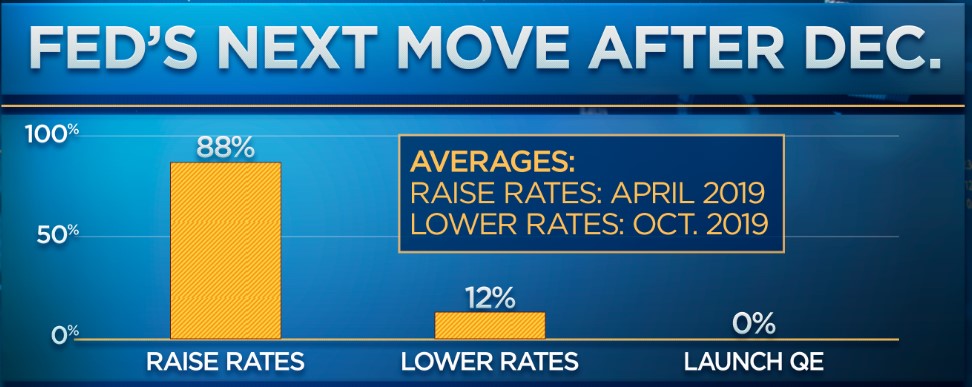In a sharp change toward a darker outlook, respondents to the CNBC Fed Survey have boosted the chance of recession next year to the highest level of the Trump presidency, reduced their support for the president's handling of the economy and lowered their outlook for economic growth and Fed rate hikes — with some even flirting with the idea of a rate cut in 2019.
Still many of the 43 respondents, who include economists, fund managers and strategists, also argued that the market has overdone it to the downside.
"The notion that downgraded growth prospects are driving the stock market sell-off is backwards," wrote Mike Englund, chief economist, Action Economics, LLC. "Stock price declines have driven the growth slowdown narrative, which thus far faces little confirming evidence from actual U.S. economic reports."
Still, the chance of recession in the next 12 months rose to 23 percent, the second straight increase, and up from 19 percent in the prior survey. That's higher than the 19 percent long run average for the seven-year-old survey and nine points higher than the low of the Trump presidency.
"Traditional signals of a U.S. recession from the shape of the yield curve to a fall in housing investment to corporate bond spreads are suggesting a recession in late 2019/early 2020," wrote Constance Hunter, chief economist at KPMG, in response to the survey.
Hunter was among the 12 percent of respondents who think the Federal Reserve, after hiking in December, would next move to reduce the Fed Funds rate and do so by October. While the percentage is small, no forecasters predicted a 2019 rate cut in the September survey.

And while the tone of responses is more negative, 63 percent of those surveyed believe the recent market sell-off reflects too pessimistic a view of the outlook, with about a third saying the market has it right. Just under 60 percent say the current low level of the spread between the yields on the 2-year and 10-year notes does not signal a recession.
"Market growth signals right now are out of line with economic fundamentals on our reading of both,'' wrote John Ryding, chief economist at RDQ. "A resolution of trade uncertainty should encourage corporations to respond more strongly to the tax changes of December 2017 and boost capex."
But Jim Bianco, president of Bianco Research, said the yield curve is "a signal the Fed is too tight and the risk of breaking the economy is rising."
Asked how different factors have contributed to the recent sell-off, respondents named "tariff concerns" as the most significant followed by worries about global economic weakness and more Fed rate hikes.
Sixty-seven percent expect that the current trade talks between China and the US will end on March 1 with an agreement to continue talking and without the imposition of additional tariffs. On average, however, the group expects tariffs to subtract 0.2 percent from growth in 2019, double the estimate from the September survey.
That among has taken on more significance now that growth forecasts have come down. The average estimate sees growth slowing to 2.3 percent in 2019 and 1.8 percent in 2020, down from just above 3 percent this year.
"The next recession is coming into view, but not in 2019 as deficit-financed government spending increases will support growth through much of the year," said Mark Zandi, chief economist, Moody's Analytics.
The uncertainty is taking a toll on respondents' approval rating of President Trump's handling of the economy. The group has generally given the president higher marks than the general public, and that remains the case. But the numbers are lower.
Just 52 percent said they now approve of the president's handling of the economy, down 14 points from the prior survey in which his approval had hit an all-time high. Disapproval rose ten points to 31 percent.
"The Trump-Navarro Trade War policy is a threat to the entire global growth direction and magnitude,'' said David Kotok, chief investment officer at Cumberland Advisors.
"I don't think I've ever been this uncertain about my forecast. The uncertainty stems from uncertainty about tariffs and about the response of nonresidential fixed investment to both tariffs and tax reform," said Robert Fry, chief economist of Robert Fry Economics LLC. "If tariffs go to 25% and stay there, my growth forecast is too high and my inflation forecast is too low. If a deal is reached before tariffs go to 25%, my growth forecast is too low…"
The S&P 500 is seen rising to just 2774 next year, down from a prior forecast of 2936. Still, from current levels, the increase would offer investors about an 8 percent increase. The outlook for the 10-year yield fell in 2019 fell to 3.16 percent from 3.56 percent in the current survey, a strong drop that reflects the recent decline in rates, but would still represents a slight increase from current levels.
The survey is taken ahead of each Fed decision.
No comments:
Post a Comment